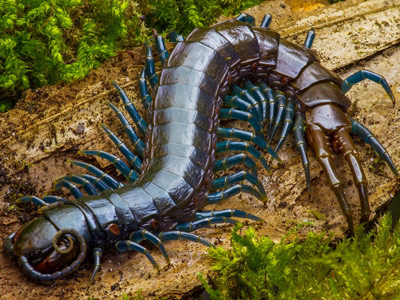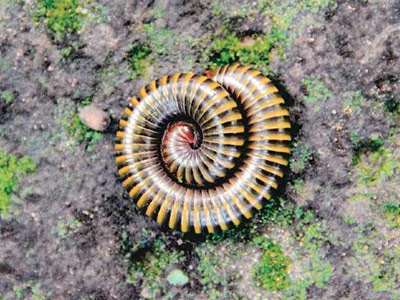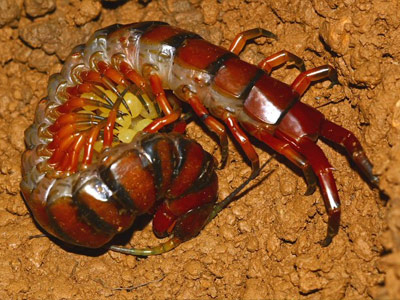They are elongated metameric creatures with one pair of legs per body segment. Centipedes are known to be highly venomous, and often inject paralyzing venom. Despite the name, centipedes can have a varying number of legs, ranging from 30 to 354. Centipedes always have an odd number of pairs of legs. Therefore, no centipede has exactly 100 legs. A key trait uniting this group is a pair of venom claws or forcipules formed from a modified first appendage. Centipedes are predominantly carnivorous.
Their size can range from a few millimetres in the smaller lithobiomorphs and geophilomorphs to about 30 cm (12 in) in the largest scolopendromorphs. Centipedes can be found in a wide variety of environments. They normally have a drab coloration combining shades of brown and red. Cavernicolous (cave-dwelling) and subterranean species may lack pigmentation, and many tropical scolopendromorphs have bright aposematic colours.
Life Cycle:
Centipede reproduction does not involve copulation. Males deposit a spermatophore for the female to take up. In one clade, this spermatophore is deposited in a web, and the male undertakes a courtship dance to encourage the female to engulf his sperm. In other cases, the males just leave them for the females to find. In temperate areas, egg laying occurs in spring and summer, but in subtropical and tropical areas, little seasonality to centipede breeding is apparent. A few species of parthenogenetic centipedes are known.
The Lithobiomorpha and Scutigeromorpha lay their eggs singly in holes in the soil, and the female fills the holes with soil and leaves them. The number of eggs laid ranges from about 10 to 50. Time of development of the embryo to hatching is highly variable and may take from one to a few months, it can take 3 years for S. coleoptrata to achieve adulthood, whereas under the right conditions, lithiobiomorph species may reach a reproductive period in 1 year. In addition, centipedes are relatively long-lived when compared to insects, for 5 or 6 years.
Females of the Geophilomorpha and Scolopendromorpha show far more parental care. The eggs, 15 to 60 in number, are laid in a nest in the soil or in rotten wood. The female stays with the eggs, guarding and licking them to protect them from fungi. The female in some species stays with the young after they have hatched, guarding them until they are ready to leave. If disturbed, the female either abandons the eggs or eats them; abandoned eggs tend to fall prey to fungi rapidly.
 |
 |
 |
Ecology:
Centipedes are predominantly generalist predators, which means they have adapted to eat a variety of different available prey. Examination of centipede gut contents suggests that plant material is an unimportant part of their diets, although centipedes have been observed to eat vegetable matter when starved during laboratory experiments.
Centipedes are mostly nocturnal. Studies on their activity rhythms confirm this, although a few observations of centipedes active during the day have been made, and one species, Strigamia chinophila, is diurnal. What centipedes actually eat is not well known because of their cryptic lifestyles and thorough mastication of food. Laboratory feeding trials support that they will feed as generalists, taking almost anything that is soft-bodied and in a reasonable size range. Earthworms may provide the bulk of diets for geophilomorphs, since they burrow through the soil and earthworm bodies would be easily pierced by their venom claws. Geophilomorphs probably cannot subdue earthworms larger than themselves, so smaller earthworms may be a substantial proportion of their diet.
Scolopendromorphs, given their size, are able to feed on vertebrates, as well as invertebrates. They have been observed eating reptiles, amphibians, small mammals, bats, and birds. Springtails may provide a large proportion of lithiobiomorph diets. Little is known about scutigeromorph or craterostigmomorph diets. All centipedes are potential intraguild predators. Centipedes and spiders may frequently prey on one another.
Many larger animals prey upon centipedes, such as mongooses, mice, salamanders, beetles and snakes. They form an important item of diet for many species and the staple diet of some such as the African ant Amblyopone pluto, which feeds solely on geophilomorph centipedes,[11] and the South African Cape black-headed snake Aparallactus capensis.
Hazards to humans:
Some species of centipedes can be hazardous to humans because of their bite. Although a bite to an adult human is usually very painful and may cause severe swelling, chills, fever, and weakness, it is unlikely to be fatal. Bites can be dangerous to small children and those with allergies to bee stings. The bite of larger centipedes can induce anaphylactic shock in such people. Smaller centipedes usually do not puncture human skin.
Even nonvenomous centipedes are considered frightening by humans due to their dozens of legs moving at the same time and their tendency to dart swiftly out of the darkness towards one's feet.
Control:
Contact your pest management professional and request an inspection, to prepare a comprehensive pest management plan that will effectively and efficiently deal with the specific pest problem.

